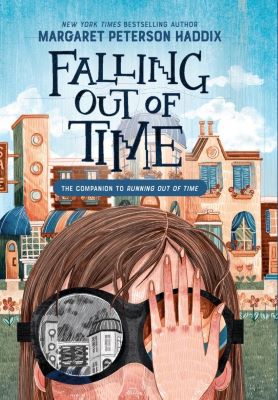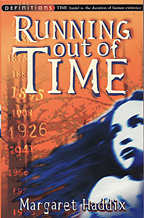Running Out of Time: Frequently Asked Questions
Note: My answers may contain some spoilers for the book—please don’t read this if you haven’t finished the book!
How did you get the idea for Running Out of Time?
I got the idea when I was working as a reporter for a newspaper in Indianapolis. I went to do a story about people who worked at a nearby restored historical village called Conner Prairie. Since it was their job to pretend to live in the 1800s, I asked them what it was like to live in one century and work in another. I was intrigued that some of them said that on slow days when there weren’t any tourists around, they practically forgot that it wasn’t the 1800s. That got me to thinking: what if there were a historical village where the tourists were always hidden, and the children were told it really was the past? I thought it was a good idea for a book, but it took me a long time to figure out the book as a whole.
Why did you pick 1840 as the time period for Clifton Village?
I had a couple different reasons—I knew I wanted to set the book in Indiana, so I wanted to pick a time when there were some settlements in Indiana, but it would still be possible for those settlements to be very isolated from the outside world. That also meant that I needed a time period before train travel was common. And I decided that I wanted Clifton’s time period to be before the word “Okay” was commonly used, because I wanted that to be a clue that something was strange about Clifton. Also, there really was a depression in the late 1830s, so it made sense that the people in Clifton had faced shortages of food, etc. Finally, I didn’t want to go so far back in time that Jessie would have no comprehension of the twentieth century. If I had set the first part of the book in prehistoric times, for example, Jessie wouldn’t have even understood the concept of money, let alone a telephone. Certainly there are other years that would have worked besides 1840, but I had to settle on something and 1840 seemed to make sense.
How long did it take to write Running Out of Time?
That depends on how you count it. If you look at the time between the moment when I first got the idea for the book, to the point at which I held the published book in my hand, it was a total of nine years. But I spent four years thinking about the book before I wrote the first word, and because this was my first book to be published, it took quite a while to find a publisher. A more accurate answer is that it took about three months to write the book, then about another three months (spread out over a couple years) to revise it into its final form.
Are you going to write a sequel to Running Out of Time?
For more than 25 years, my answer to that question was "I would if the right idea struck me, but that hasn't happened yet." But I'm happy to report that my answer has changed: The sequel/companion book, Falling Out of Time, came out in 2023! 2023!



 British
British Chinese
Chinese
Connect with Margaret: